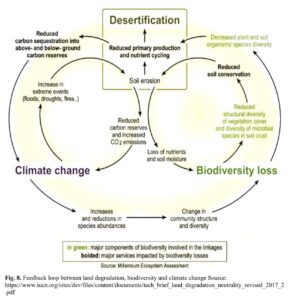Desertification is one of the major issues threatening human communities. Many methods have been developed for assessment and mapping of desertification hazards. In this research, multi-criteria evaluation method was used to investigate desertification process in Trouti watershed, Golestan Province, Iran. At the first step, major desertification factors were determined by doing field surveys. They were […]
The UNCCD has been ratified by over 190 countries. It is the attempt by nations, both rich and poor to control the scourge of desertification. The definition of which is “land degradation in arid, semiarid, and dry subhumid areas resulting from various factors, including climatic variations and human activities. It is now widely accepted that […]
Several studies have been performed to evaluate the desertification in Iran and other countries which led to present national and regional models. One of them is IMDPA model. This model was used as a case study in Taraz Nahid, Saveh, Iran. In this study, five factors including climate, soil, vegetation, irrigation, and socioeconomic ones were […]
Floodwater spreading for the artificial recharge of groundwater (ARG) is a logical alternative to build large dams for water resources management in dry environments so that it not only enhances water security, but also reclaims the degraded land due to the settlement of suspended load on the spreaders. However, translocation of very fine clay minerals […]
More than one-third of the earth is characterized by arid and semi-arid climate and desertification phenomenon in these areas has been intensified in recent decades. This study aims to investigate the trend of desertification using vegetation indices and Iranian Model of Desertification Potential Assessment (IMDPA) in Abarkooh Plain, Yazd province, Iran. The satellite images (Landsat […]
Description of vegetation patterns associated with environmental factors such as grazing, climate, landforms, substrate variables etc. are helpful for land management planning. This study used new synecological tools to investigate plants composition and to provide ecological descriptions of plants communities of communal pastures in Sahelian Ecological Zone of Niger. Vegetation and several environmental variables were […]
It is very easy to view land degradation and desertification as purely biophysical phenomena for which there are neat technological solutions. Yet millions of real people live in the affected lands, and they both cause land degradation and are impacted by it, so scientists and land managers need to find a good balance between reductionist […]
